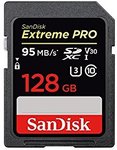I have looked around online for a while and this is(as far as I have been able to find) the cheapest 128GB Extreme Pro out there where you are guaranteed to get a real SanDisk card.
It is a good card if you are planning to record videos etc. The writing speed will prevent any issues with throttling.
The V30 marking on the card stands for a minimum writing speed of 30 MB/s


 CamelCamelCamel
CamelCamelCamel
Can it be used on Nintendo switch?